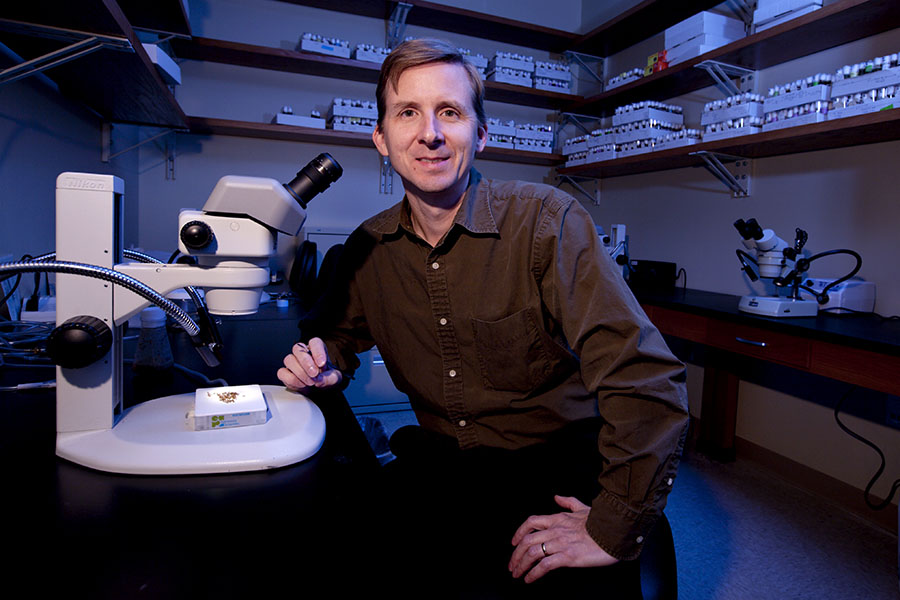
Turns out, even your cells hate traffic jams.
In order for cells to function properly, they need to be able to coordinate traffic within their walls and let information flow in and out.
Inside a cell, molecules, organelles and information travel along microtubules, which work like highways or conveyor belts. Backups can occur if the information isn't organized and moving efficiently through the microtubules.
In a paper published in the journal Nature Cell Biology, Florida State University College of Medicine Associate Professor Timothy Megraw and colleagues provide an understanding of how microtubules are assembled and organized.
They also identify a mechanism that keeps the cellular information flowing smoothly. Avoiding jams is critical for the transfer of collagen, a protein necessary for healthy function of internal organs.
Studying the mechanism also can provide an important foundation for understanding human diseases.
"Microtubules are important for a variety of cellular processes," Megraw said. "Molecules get transported along them like cables to enter and exit the cells. Typically, a cell will have a centrosome, which organizes the microtubules. The cables start from the centrosome and go outward."
Until recently, that would have been the makeup you'd expect to see within a fruit fly's fat body cell. But Megraw and his team uncovered a new system at work in fat body cells, which are analogous to human liver cells.
The team discovered that the cells have a unique center on the nucleus that oversees the organization of the microtubules and serves other cell functions.
It's different from a centrosome and is scientifically known as a non-centrosomal microtubule-organizing center (ncMTOC).
"In these cells, there's a big nucleus and the microtubules come out from there like a big sun radiating outward. Most cells don't have that," said Megraw, who co-authored the study with Yiming Zheng, a former Department of Biomedical Sciences doctoral student. "Yiming determined what that center is composed of, how it works and what it does for the cell, which are all very novel things."
The organizing centers, or ncMTOCs, determine the position of the nucleus, which can vary depending on cell function. They also ensure that collagen is efficiently secreted out of the cell.
"Fat body cells, similar to our liver, provide the collagen for the whole rest of the organism," Megraw said. "Collagen maintains organ integrity. Without it, the organs kind of fall apart."
The organizing center ensures that the cell can not only secrete collagen but do so efficiently via the microtubules in order to avoid molecular traffic jams.
"If we just knock out the microtubules, then it's really inefficient," he said. "Some of it happens, but it's dramatically reduced as an indirect effect of failed trafficking. What we showed was that the trafficking is key in the retrograde (or backward) direction. The collagen molecules get out, then there's a block in the recycling of materials, so everything gets clogged up.
"But also, if we don't directly disrupt microtubules and instead destroy the ncMTOC - the place they're organized from - then we get the same effect. So, you don't just need microtubules; they also have to be organized properly."
The study went on to reveal more mysteries about how exactly the organizing centers are assembled. Two proteins - patronin and ninein - stimulate the assembly of microtubules together with a well-known microtubule polymerase that was not known previously to work cooperatively with the proteins. This molecular framework provides a novel mechanism for how the organizing center works.
By studying this process, researchers can uncover more clues about how and why things go wrong in cellular processes that are unique to differentiated cell types.
For example, similar to the fat body cells that Megraw and his team studied, mature muscle cells also have a microtubule organizing center on the nucleus, which could be important to the study of muscular dystrophy and premature aging syndromes.
"There are several unique features even though they kind of look the same," Megraw said. "But I think the platform molecule that's associated with the perinuclear muscle ncMTOC, called nesprin, may be a common feature, which may be why its disruption has so many disease associations."
The team's research, which was funded by the National Institutes of Health, lays the groundwork for further exploration of cells' organizing centers and their specific roles in different cell types.
"I think we can use this to explore more of the diversity," he said. "How do each of the diverse cell types in our body organize microtubules from their ncMTOCs to accomplish their unique cell and tissue functions?
"Different cells have unique roles that they serve to the whole organism, and microtubules are important in every cell, so I would assume their organization is, too. There's a lot for us to explore and discover."






